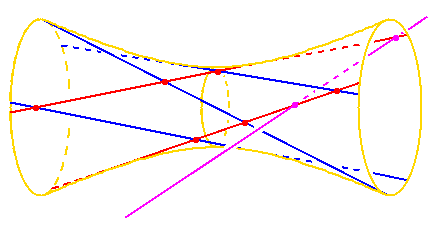

One way to see this is to first consider the
3 blue lines.
If they are mutually skew, they will lie on a
hyperboloid of one sheet.
On the
hyperboloid of one sheet,
there are two families of lines,
and each member of one family meets every member of the other family.
The blue lines are in one family, and the set of
lines which meet all
3 blue lines is the other family
(in red).
If we now consider the fourth
maroon line, it will meet the
hyperboloid in two points, the
maroon dots.
Through each of these maroon dots
there will be a unique line in the second family.
These two lines are the two lines which meet our
four given lines.
This picture illustrates a feature of the real numbers, that the number of solutions to such questions may depend upon subtle properties of the configurations of the conditions. It is in general a difficult problem to determine how many real solutions there are. An upper bound is given by the number of complex solutions. One may ask:
When is this upper bound attained by real solutions?
A recent theorem of says that this upper bound is
reached on many problems in enumerative geometry that arise from Schubert's
calculus. It is also attained for certain problems of
counting rational curves in a Grassmann variety, and for many problems
involving flags.
